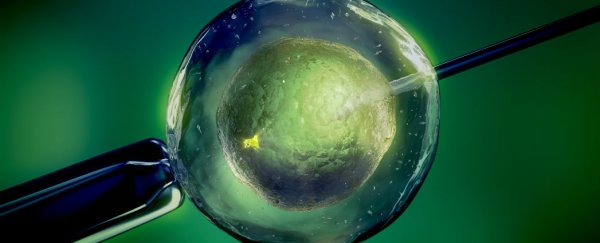For the first time, scientists have shown that it's possible for two people of the same sex to create a baby, without the need for outside egg or sperm donation. The most obvious benefits would be for homosexual couples who want to have a child together, but the method could also help couples who have been affected by infertility.
The team, from Cambridge University in the UK and Israel's Weizmann Institute of Science, built on previous work where baby mice were successfully raised from mouse skin cells that had been converted into what's known as primordial germ cells - the precursors of egg and sperm cells. It was a real struggle to replicate the process using human biological matter, but now they've finally managed to create new human primordial germ cells using skin cells from five human donors and stem cell lines from five human embryos.
"We have succeeded in the first and most important step of this process, which is to show we can make these very early human stem cells in a dish," lead researcher and professor of physiology and reproduction at Cambridge, Azim Surani, told Lois Rogers at The Sunday Times.
"We have also discovered that one of the things that happens in these germ cells is that epigenetic mutations, the cell mistakes that occur with age, are wiped out. That means the cell is regenerated and reset, so while the rest of the cells in the body have aged and contain genetic mistakes, these ones don't. We can't say no mutations are passed on, but mostly it doesn't happen."
A pioneer in the field of non-traditional reproduction technology, Surani was also involved in the birth of the first test-tube baby, Louise Brown, in 1978.
The key to their research ended up being a gene called SOX17, which didn't seem to have any effect on the mouse research, so was largely ignored. But the team finally realised that SOX17 was actually crucial to process of 'reprogramming' that the human skin cells had to undergo to become primordial germ cells, and they reported their discovery on Christmas day last year.
Now, they're confident that the process, which has been described in the journal Cell, could be used to make healthy babies in as little as two years' time. Although Robin Lovell-Badge, head of stem-cell biology and developmental genetics at the National Institute for Medical Research, who was not involved in the work, thinks it's too soon to be putting a due date on it. "[The stem cell breakthrough] will be important for understanding the causes of infertility and for the treatment of it," he told Rogers at The Sunday Times. "It is probably a long way off, but it would be a way for people who have had treatment for conditions such as childhood leukaemia, which has left them infertile, to have children of their own."
Of course, something like this is bound to get caught up in ethical concerns, as did the research that resulted in the birth of a girl using the DNA of three parents. But Surani's team point out that reproduction is not the only potential use for this technique. He told Ian Sample at The Guardian that because the cells are wiped clean of the genetic mutations they had accumulated as skin cells, they could be used to better understand the changes our cells undergo as we age. "This could tell us how to erase these epigenetic mutations," he said. " Epigenetics is used to regulate gene expression, but in age-related diseases, these changes can be aberrant and misregulate genes."
As Lovell-Badge said, it's much too early to know if this is the medical breakthrough that will change the way we reproduce, but it sure does feel like the not-so-distant future will offer a whole lot more options to the kinds of people who are struggling to have a baby today. And ethical arguments aside, that's a pretty wonderful thing.
Sources: The Guardian, The Sunday Times
